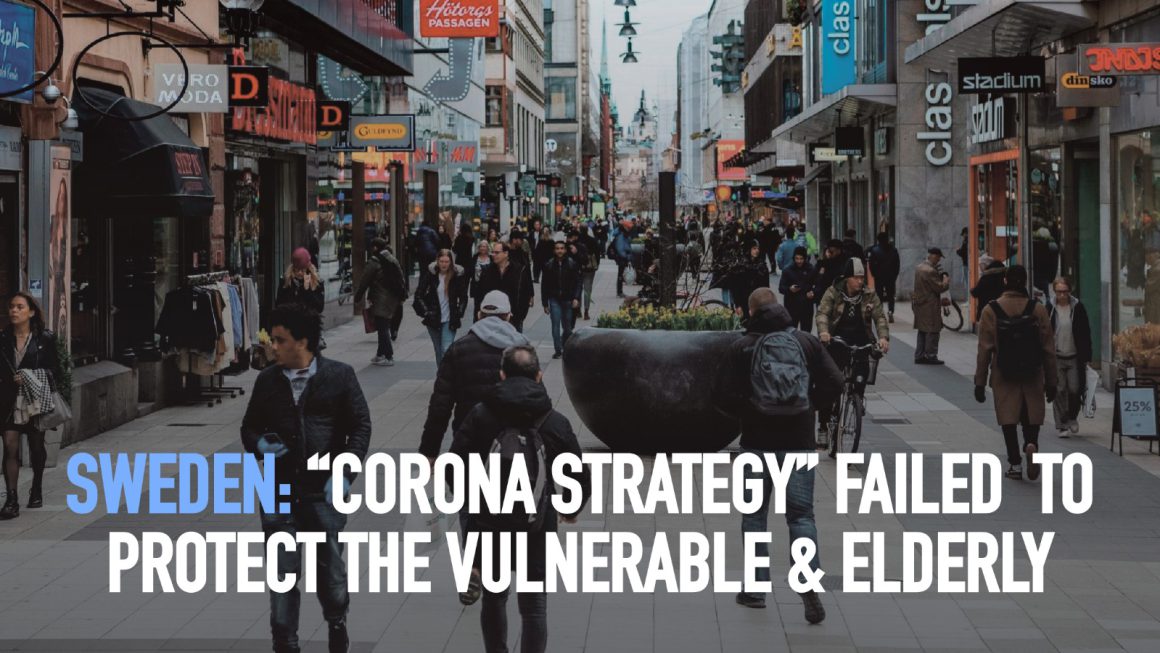By Jonas Brännberg (Rättvisepartiet Socialisterna- our sister organisation in Sweden)
Three months have passed since the corona pandemic reached Sweden, and although it has a significantly higher death rate than neighbouring countries with no improvement in sight, the government and authorities have so far escaped wider criticism, partly because of the uncertain state of knowledge but more because of the nationalism that has been whipped up. That the “corona strategy” failed with one of its main goals — to protect the vulnerable and elderly — is obvious. Now the right-wing opposition is trying to use growing anger to its own advantage. However, real change and effective control of the spread of infection will require something completely different — a mass movement from below.
Crises tend to exacerbate society’s contradictions and accelerate the trends that are already developing. The Corona crisis, although different from all other crises in modern times, is a typical example of this. The increasingly nationalistic approach of the political establishment in recent years has really exploded during this crisis, perhaps best symbolised by the speech of Prime Minister Stefan Lövfén on 1st May standing in front of nothing but Swedish flags. While the virus has been most deadly for the vulnerable in the austerity-stricken elderly care sector and in the poor suburbs, the rhetoric of the politicians has been that we are all equally vulnerable.
The Public Health Authority (FHM) and state epidemiologist, Anders Tegnell, have been placed on a nationalist pedestal by the media and politicians in order to obfuscate criticism of their actions. Hate and threats against Tegnell have been used by the establishment to silence critical voices.
Internationally, the use of anti-democratic measures by increasingly authoritarian regimes to push back the rights of the working class has grown exponentially during the Corona crisis. Not only has Orban used dictatorial measures in Hungary, but many countries have introduced bans on demonstrations and restricted freedom of expression. Police brutality in the United States following the murder of George Floyd is another example of how the state is taking new steps towards more oppression in an era of post-Corona economic crisis.
Even in Sweden, the right to demonstrate has been restricted and “crisis agreements” with horrific conditions have been forced on workers in, for example, Handels, the Commercial Employees’ Union.
What has pushed backed nationalism and false claims that we “are all in the same boat” has been struggle. In Belgium, workers, through strike action, forced the closure of industries that could not guarantee protection from contagion, and health workers have turned their backs on ministers and forced the politicians to back down from new austerity proposals.
The provision of face masks has, in Sweden, been the issue that shows that struggle pays off. Numerous safety shutdowns, especially by shop stewards in Kommunal, the Municipal Workers’ Union, has brought the need for complete PPE to the forefront. Thanks to the trade union struggle by bus drivers in Stockholm, front doors were closed early on during the epidemic, so passengers entered at the rear, which probably saved many lives.
The campaign at Serafen’s retirement home shows how the Work Environment Authority adapt safety requirements to employer interests by accommodating the demands of Sweden’s Municipalities and Regions and riding roughshod over its own experts who first, after an independent assessment, concluded that respiratory masks were needed during any contact work with patients.
Is the situation in Sweden worse?
Sweden’s “Corona strategy” has totally failed. Half of all those who have died in Sweden because of Covid-19 have lived in retirement homes and a quarter have had home help. 90 percent are who have died are over 70 years old.
Some explain, again with a degree of nationalism, the high number of fatalities by pointing out that other countries do not have reliable statistics, but whatever way it is calculated, the Swedish death toll is disastrous.
It is true that, in many cases, official death figures from Covid-19 are more a measure of how corrupt and authoritarian the regime is, than how many or how few have died. There are states that do not accurately know their population, never mind how many have died from Covid-19. Even countries in Europe, such as the United Kingdom, have only recently counted all deaths, including those occurring in homes for the elderly.
The use of more reliable statistics, like excess mortality rates, which show how many more people have died compared with an average year, show that Sweden has a high number of deaths. In Italy, Spain and the United Kingdom, excess mortality rates at their worst rose to over 100%, showing that there were twice as many deaths as normal, but countries such as France at 55% and Sweden at 45% are also high.
For Sweden, however, it is more natural to compare with the other Nordic countries, due to similarities in demography, health status, population density and so on. Then the figures become even more disastrous with five times more deaths per inhabitant than Denmark and ten times more than Norway and Finland.
An important explanation is neoliberal right-wing policies. After decades of cuts and the privatisation of the welfare state in general, and social and elderly care in particular, preparedness to deal with a pandemic was dramatically reduced from the very outset.
Sweden already had the lowest number of hospital beds per capita in the EU and the second lowest number of intensive care places, pharmacies have been privatised and all medical and other pandemic stockpiles have been slaughtered on the altar of cost “savings” despite repeated warnings.
Hospitals have barely managed to keep their “heads above the water” during an almost war-like situation: planned operations have been cancelled, crisis agreements have been introduced with almost inhumane workloads for staff and operating theatres have been hastily converted into intensive care units. In this way, the number of intensive care beds has more than doubled in a few weeks.
There are signs that elderly people, perhaps unconsciously, were “excluded” from intensive care, as the proportion of older Covid-19 patients in intensive care is significantly lower than in neighbouring countries.
For elderly care in homes, however, there has been no quick fix. After massive privatisations, the sector has been fragmented into many different units, in which equipment, training and sensible working conditions have been sacrificed to lower costs and increase profits. In the City of Stockholm alone, there are 176 different home help companies!
Last week, the Health and Social Care Inspectorate (IVO) published a widescale review that showed serious deficiencies in every tenth facility in the elderly care sector. This was based just on surveys that were carried out remotely.
The chaos in elderly care has been devastating during the pandemic. Elderly people who have been infected have not been separated from healthy people and staff have been forced to work despite being ill. Others have been forced to care for the sick without protective equipment, a large proportion of staff are paid by the hour and could not afford to stay at home. Nevertheless, sick leave has made staff shortages even more significant. Unskilled substitutes have been forced to run between healthy and sick service users. No consideration has been given to risk groups who are forced to work as usual, despite the lack of protective equipment.
The result has been a disaster. On some retirement home wings, more than half of the residents have died while in the entire home, a third have died in a few weeks. Privatised health companies have made remote diagnoses and just provided palliative care for elderly people who could have survived. The fact that Stockholm suffered the worst is probably not only because it is the biggest city, but because elderly care has been most extensively privatised.
Failed Strategy of the Public Health Authority
The Swedish failure is just as much about the dire situation in the elderly care sector after years of cuts and privatisations, as it is about the “strategy” and restrictions of the Public Health Authority (FHM) and the government, even though they have made mistake after mistake. Initially, FHM denied the epidemic would spread from China, and then, on 2nd March, Director General, Johan Carlson said that in a worst-case scenario, just 1–1.5% of the population would become infected. They then underestimated the spread of infection in Europe, especially from Italy, as Swedes travelled there during the spring mid-term break. If Sweden, like other countries, had encouraged everyone who returned from northern Italy to isolate themselves for two weeks, a large part of the infection spread could have been avoided. At the beginning they said the virus did not spread on public transport, only to later discourage people from travelling on public transport at all.
While FHM pointed out that all measures taken must have a “scientific basis”, the agency’s actions have been based on optimistic hopes, rather than on an important pillar of science, that it’s “better to be safe than sorry”. FHM’s hope that better public health and well-medicated risk groups would mean that Sweden would manage better proved to lack any scientific basis.
FHM still claims that asymptomatic infection has very little significance, even though, for example, the United States’ public health institute estimates that 35% of those infected are asymptomatic and that 50–100% of those are contagious. As a result, by not encouraging the use of face masks, a potentially unnecessary contagion risk is left unchecked.
A dangerous about-face
Once the infection began to spread in the community, FHM overestimated the contagiousness of the coronavirus, and as a result underestimated mortality. Instead of demanding continued testing and contact tracing in the regions, FHM claimed “there are insufficient resources” and that, inevitably, the Coronavirus would sweep over the entire population. “Suppressing the virus may be possible in China where you can weld people’s front doors shut but it is not possible in a democracy” was a mantra that was repeated many times by FHM’s adviser, the former state epidemiologist, Johan Giesecke.
However, what neighboring countries as well as Greece, Austria, South Korea and Israel have shown, that it is possible to push the rate of infection down to very low numbers, even if there was widespread contagion at first.
Despite all these mistakes, the Public Health Authority still insists they are right with reference to the risk of a second wave of the virus emerging as, it says, Sweden will be better protected as there has already been a wide spread of infection and therefore immunity. Another claim based on pious hopes rather than science.
The government to blame for elderly deaths
The government and the responsible authorities have proved totally ignorant of the state of affairs in elderly care. They have ignored years of warnings and protests from staff and unions about the unsustainable situation in the sector, all alarm bells should have been ringing that a general spread of infection could lead to this type of disaster. Instead, the authorities contented themselves by saying “basic healthcare hygiene” was sufficient and dismissed the need for protective equipment in elderly care. Even today, elderly care staff do not even have basic face masks to protect the elderly from asymptomatic infected staff.
Since the beginning of the crisis, the government has hidden behind “expert knowledge”. The minister responsible for health and social care, Lena Hallengren, said in February that Sweden was well prepared for the emergency, but when reality proved otherwise, blamed the regions and municipalities, or sluggish state agencies.
Now the biggest scandal is that Sweden has still failed to increase testing rates which, Lena Hallengren promised in early May, should by now be 100,000 tests per week. Yet by the beginning of June, Sweden had barely tested more per head than Finland, even though it had confirmed four times more infected. During the last week of May, only 28,000 had been tested, just over a quarter of the target. As in elderly care, testing has been slowed by the presence of too many organisations being involved, privatisations, the lack of emergency stockpiles and staff.
Even in Stockholm and other severely affected regions mass testing, starting with key groups in society that come into contact with many people, would have an effect in pushing back infection rates. What holds back a truly effective fight against Corona is the extreme under-funding and the for-profit privatised and fragmented health and social care sectors: everything from hospitals and homes for the elderly, to pharmacies, pharmaceutical companies, labs and the manufacturers of protective equipment.
Politicians and agencies who are all part of the same system that has maintained and defended today’s situation for decades are both unable to see or do anything about these problems. What is needed is a massive grassroots campaign for a permanent upgrading of the welfare system with demands for the re-nationalisation of all health and social care, of pharmacies, pharmaceutical companies and with operations controlled by the staff — the real experts — on the basis of need rather than profit or the politicians’ demands for cuts.
Such a movement will, of course, come into complete conflict with the interests of the large corporations and banks who do not want to pay a penny in taxes, but who now want to empty the state’s treasury to maintain their own power and wealth. They will, by any means necessary, prevent real public investment in health care, while at the same time they will do everything possible to continue the lucrative looting of the welfare state through the publicly funded but private operation of health and social care.
The Corona crisis has exposed the ugly nature of right-wing politics, paralysed by what could be a fully manageable situation in another society. With nationalist smokescreens and the transfer of responsibility to “unpolitical scientific” authorities, the government hopes to escape responsibility. So far, this has had some success but sooner or later reality will catch up with them.
A grassroots rebellion for healthcare is also necessary to prevent the blue-brown right-wing opposition from scoring cheap points by criticising a reality for which they themselves are largely responsible. Out of the struggle for welfare, more and more will draw anti-capitalist conclusions. It is not only the health sector that is ill, the whole of society is sick, and it is socialism that is the remedy.Rättvisepartiet Socialisterna ISA in Sweden calls for:
- The immediate provision of contagion protection for health and care staff and other vulnerable workers. State production of protective equipment and tests now by taking the necessary resources from private companies.
- All temporary staff to be given permanent jobs with training during paid working hours with full compensation in sickness benefits, temporary parental allowance, infectious carrier allowance and severance pay.
- Massive government investment to strengthen testing, contact tracing and the isolation of those who are infected. Virus testing in all suspected cases! Disinfection and free access to hand sanitisation in all public places, public transport, etc.
- An increase of government grants to the regions and municipalities by 50 billion kronor now for health and social care in public ownership without private profit interests. Stop all austerity plans immediately and develop emergency plans under the control of health care professionals and the unions to expand capacity as soon as possible.
- An end to the fragmentation and draining of resources caused by the market in healthcare. Immediately take all private, profit-making activities into public ownership. Focus on care, not market thinking and bureaucracy. No to New Public Management and “Just in time”.
- The nationalisation of the pharmaceutical companies, the production of protection and medical equipment in order to plan operations according to the urgent needs of today and the long-term needs of society.
- An end to capitalism’s hunt for profits, super-exploitation of people and nature, top-down management and the culture of secrecy which gave the virus free space and laid the foundation for today’s crisis.
- The democratic socialist planning of the economy, prioritising human health and well-being and a sustainable relationship with nature over the profit interests of a small super-rich, powerful elite.











